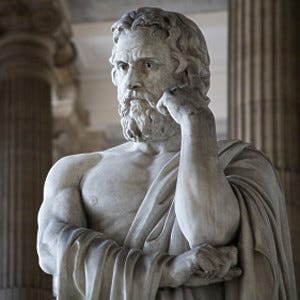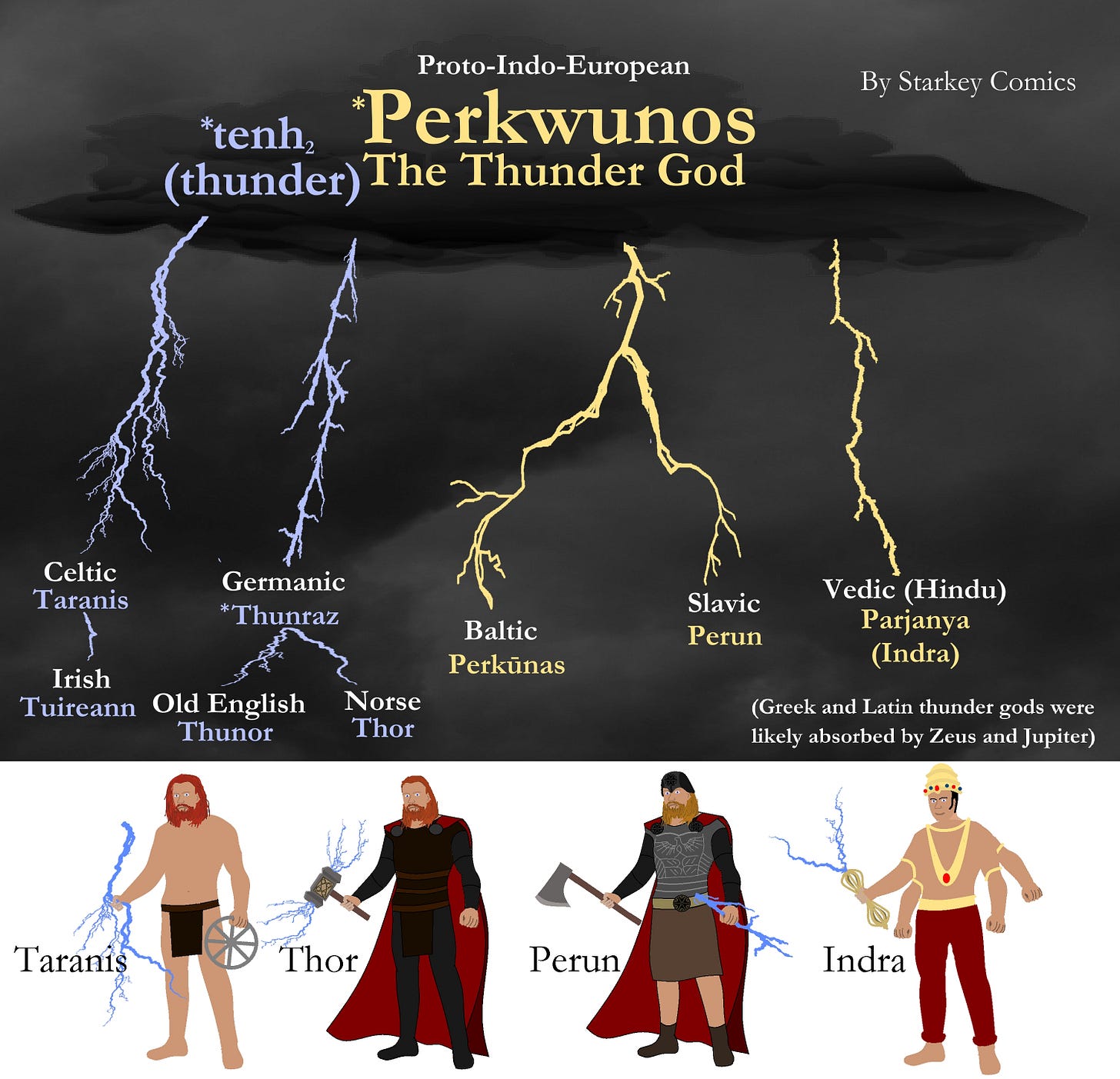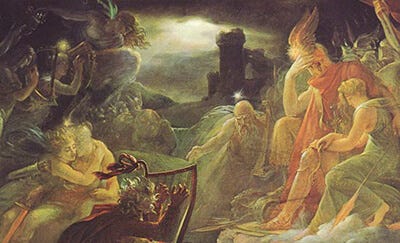This article will address the controversial interpretation of mythology known as “euhemerism” which has been utilized by many ancient and modern thinkers, ranging from Herodotus (an ancient Greek historian) to
(a modern German video essayist). This article is not an attempt to cast any shame on these euhemerists, rather it is an explanation of the euhemeristic approach, followed by an overview of the controversy that surrounds this approach, ending with my own views concerning euhemerization. This debate is honestly quite important to the folkish individual such as myself, for non-heathens often attempt to euhemerize our divinities as a way to strengthen their own position and preferences against an ancestral religion that they feel is outdated and superstitious.Since this debate hasn’t even been properly outlined and the sides clearly defined, I feel as though heathens and non-heathens simply talk past each other without fully understanding the complaints and criticisms from either side. This article is a humble attempt to rectify the issue, and provide both sides with a more concrete understanding of the debate itself.
What is euhemerism, and is there a better approach?
Let’s cover the word itself. It comes from Euhemerus, a Greek mythographer who lived in the 4th century BC. Other writers before him touched on the topics he would later write about, but none had the influence of Euhemerus. He produced a rationalizing interpretation of mythology that claimed the divine powers were in fact deified humans, and this idea took root amongst the Skeptics (including other philosophical schools) and eventually spread into Platonism and Christianity.
Countless ancient writers utilized euhemerization as a way to rationalize the mythologies and legends of ancient peoples. This need to rationalize things came out of a feeling that religion is the superstitious beliefs of peasants. This idea is still rampant today, and it is the main reason why people turn away from bona fide folkish religions in the first place. Paganism, heathenry, and peasantry have all been commonly associated with each other by euhemerists, and so the traditional religious views of our ancestors have been taken and misinterpreted as historical narratives of living men, rather than mythological legends of divine beings.
Euhemerism has been used by Cicero to claim that Zeus was just a King, and it has been used by Herodotus to describe a great number of foreign gods. The Oera Linda Book completely euhemerizes the entire Germanic faith. This is a controversial text often claimed to be a complete hoax but which does have some interesting proofs to some of the narrative. Regardless of the myriad of euhemerized religious stories, pagans have outright rejected this interpretation to instead pursue two other interpretations of history and religion:
Archaeo-genetics
Comparative mythology
Through studying archaeo-genetics, we can identify exactly who are ancestors were, and where our ancestors came from. The more samples we identify, the more studies which are done in good faith, the more knowledge we gain. Some euhemerists claim that these studies are politicized. This proves they don’t look enough into the matter, because the enemy does politicize genetic studies but they do so first by attempting to use CRT race-denial, and if that cannot work, then they will push for bizarre theories such as the pet theories of David Reich or those of jewish nationalists. These pet theories are always shot down owing to being inaccurate. The steppe-urheimat theory has gained enough traction to allow for deep studies to be committed, and we can identify the exact ancestors for countless Indo-Europeans.
Through comparing the mythologies of different Indo-European tribes, we realize that they share common myths concerning their Gods and ancestors. None of these mythologies mention the euhemerized accounts, but they instead affirm a more traditional understanding of the blood-and-soil connection that each tribe had with their land. So, instead of attempting to rationalize the mythologies of ancient Europe, we should be affirming them and accepting them as bona fide religious tales.
The Controversy
The mythologies of Europe are often picked apart by people who do not view those stories in a religious light. Thus, things get rationalized, cut away, or parsed through a foreign frame of understanding. This “cutting away” tends to include the complete removal of any deeper spiritual understanding related to the myths. This is why it is so controversial among pagans. In fact, Jesus is often euhemerized by liberals or atheists and this upsets Christians to no end. The controversy is that euhemerization could be applied to any divine being mentioned in myth regardless of the deeper spiritual views held by the folk who revere and worship these divine figures.
The main culprits have been Christians, but earlier Skeptics also played around with these ideas. However, I am particularly going to focus on the euhemerization of Odin. For starters, Odin/Woden/Wotan is a Germanic and Nordic God who has roots going back to the Bronze Age, if not before. When I say he has roots going back to the Bronze Age this is what I mean: the religion of the early Bronze Age Indo-Europeans shaped the later religions of their descendants, and many of these Gods share common origins. This meme about the Thunder God encapsulates this progression from the primordial steppe to the later Iron Age tribes we all know so much about.
OK, so Odin is the King of the Aesir, the leader of the divine pantheon, the All-Father of the Cosmos. The All-Father figure, the divine king of the divine beings, is a recurring element in all Indo-European religions. The Proto-Indo-European Dyeus Pter is the same concept, but the term dyeus has confused many people owing to the deep spiritual meaning it carries. The divine kings of the other pantheons are likewise the same concept. This is an ancient figure who was identified by a very early Bronze Age peoples (probably much earlier though) and his worship was continued in different forms by their descendants. For example, the Gaelic version is named the Dagda who is given the epithet of Eochu Ollathair, Horse All-Father. Just like Odin, he is the highest figure, skilled in magic, an old blind wanderer with power over life and death; just like Odin, he is named the All-Father. This means the All-Father comes from a deeper root than just the Gaels or the Germans. This figure comes from our shared origins back on the steppe in the early Bronze Age (and probably beyond).
Now we know where Odin came from, but what about the euhemerized myths? Well, there are a few different accounts, but they all say the same basic thing: Odin was a great chieftain from the steppe who led the Germanic and Nordic tribes into north-central Europe in the Bronze Age. This theory was even pursued by Thor Heyerdahl, a famous adventurer I quite respect. However, all evidence that can be found concerning this theory simply points to the actual archaeo-genetic reality of the Indo-Europeans who moved into western Europe, which includes more than just the Germanic peoples. Basically, the timeline to this euhemerized account just makes no sense. Odin can’t have been a chieftain from the Scythians or any other group of that sort because his roots exist in an even deeper past and he is just one of many All-Father figures who comes from the far older Proto-Indo-European Dyeus Pter.
Just look at the timeline of Y-DNA migration patterns found on Eupedia. The timeline of the euhemerist accounts make no sense. The ancestors of the Germans and Nords were living in Europe before the Scythians appeared on the steppe. Odin has direct parallels to other Indo-European All-Father figures. This all means that Odin came from an earlier source than Scythia or any other candidate like Troy or something.

My Take on Euhemerization
Ultimately, I reject the wholesale adoption of euhemerism as a proper way to interpret mythologies. For non-heathens, this has become a tool in their arsenal that they utilize anytime they cannot bring themselves to call one of their ancestral gods a demon, so they instead euhemerize them into mighty men or women who did such great feats that they were deified by their superstitious ancestors. I generally find this approach distasteful since it ignores the entire religious argument, as I explained above. My views on euhemerization are heavily influenced by the fact that I do have bona fide religious views towards these figures, and the attempt to lessen them to mere men is sacrilegious.
To really make this point clear, the Christian monks took every single pagan god of Ireland and euhemerized some of the good ones, and demonized the rest. The entire Tuatha de Danaan and the Fomorians are treated as earlier humans who inhabited Ireland before the Irish, albeit magical humans and ancestral to the Irish. This sort of re-writing is horribly inappropriate. Many of the euhemerized gods have clear analogues in other Indo-European cultures, showing that they share an even older root. Therefore, the rationalization that the Gaelic gods are just pre-Gaels or even early Gaels is inaccurate simply according to the timeline. Of course, euhemerists would then take the mundane origin of those gods back to an earlier tribe and earlier man, but that does not change the fact that euhemerization hasn’t been used as a way to properly study history, instead used to de-legitimize pagan religions.
Now, with all of that said, I think there are cases where euhemerization might be more benign and not as negative in intention. For example, I can imagine our ancestors naming a child after a god or goddess (such as Bridget or Maeve) and then the stories of these very human figures getting wrapped up with the actual god or goddess, leading later writers to assume that the god or goddess was simply fabrication based around an impressive person who did truly exist. This sort of situation would require deep study to prove for any individual case, so euhemerization cannot simply be assumed. We have to study these myths and identify when Christians have utilized euhemerization, and when they haven’t.
Likewise, I could imagine our ancestors mistakenly attempting to deify a man who didn’t deserve it, largely done out of loyalty, social pressure, or some other influence we cannot discern. If a man’s descendants attempted to lift him up to the Divine, and the Divine rejected him, this may not be known to mundane folks and they might still remember him in a divine light. I cannot name any particular being who I think this may have happened to within the Indo-European world, but this is something that I have considered in relation to this debate.
I think that euhemerization is largely useless as a scholarly tool interpretation, but it sometimes has merit when dealing with cults of personality that formed around charismatic kings and leaders. Overall, euhemerism does not have to be adopted wholesale by the folkish individual. However, we can use this as a tool for ourselves, mostly to use euhemerization as a way to push the envelope and force Christians to consider the controversy here. Who is Jesus of Nazareth if not a deified semite? Ah, now the Christians understand why folkish heathens have no interest in debating euhemerization and wish to completely throw it out.
As an interpretation of mythology, euhemerization is crude and unwanted by anyone who views their respective mythologies in a spiritual light. Who wants their religion to be surgically attacked with euhemerization? Who would truly desire their gods to be turned into mere men by unrelated scholars who do not care for their religion? Christians do not like this sort of interpretation of Jesus, and heathens certainly do not approve of this interpretation of Odin, or any of the other Gods, therefore it would be incumbent upon us to better identify when euhemerization happens and then nix it from the myths.
Hail the All-Father! Hail victory! Thank you, and good-end! o///







Great piece. As someone who is often accused of Euhemerism, I do think a distinction needs to be made when it comes to grey areas. One such is the Horse-Twins. While no doubt they were a real part of the IE Pantheon, they are often projected into any set of twins located anywhere, as some have done with the figures Peredur (Peredurus) and Gwrgi (Owain or Eugenius) the twin sons of Eliffer. This comes from poring through the pages of later texts such as De Gestis Britonum searching for any possible parallels. These and many others (even Arthur himself who some try to equate with the god Alator) were no doubt real figures, but when pointing out that they were real, many reconstructionists will cry "EUHEMERISM".